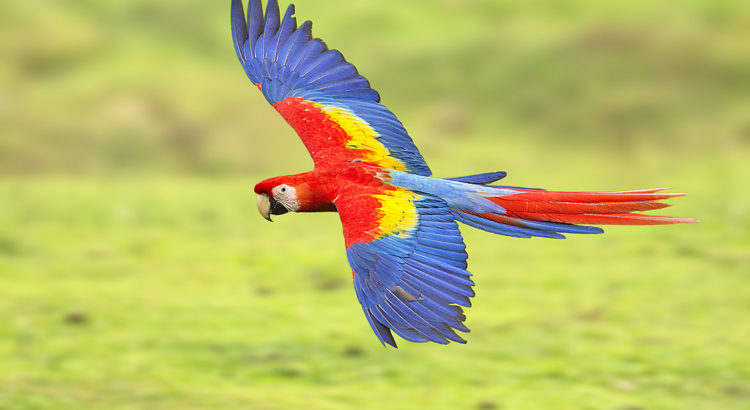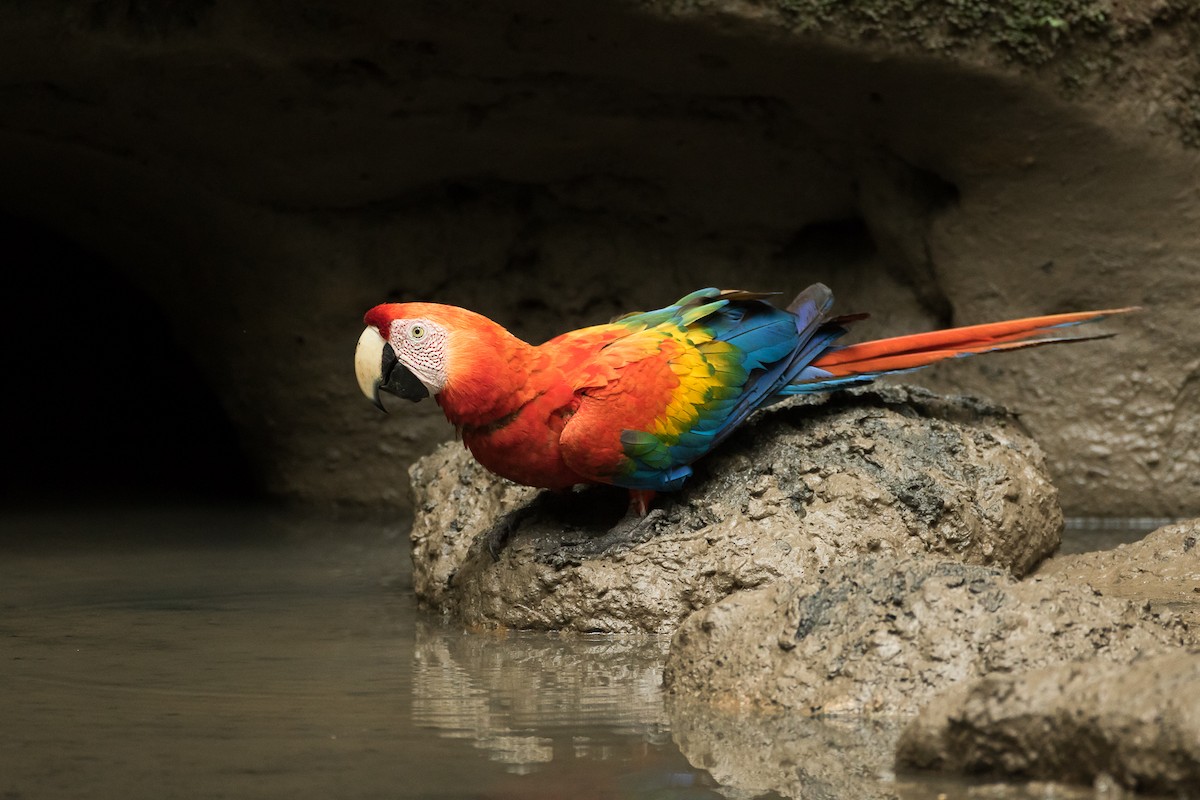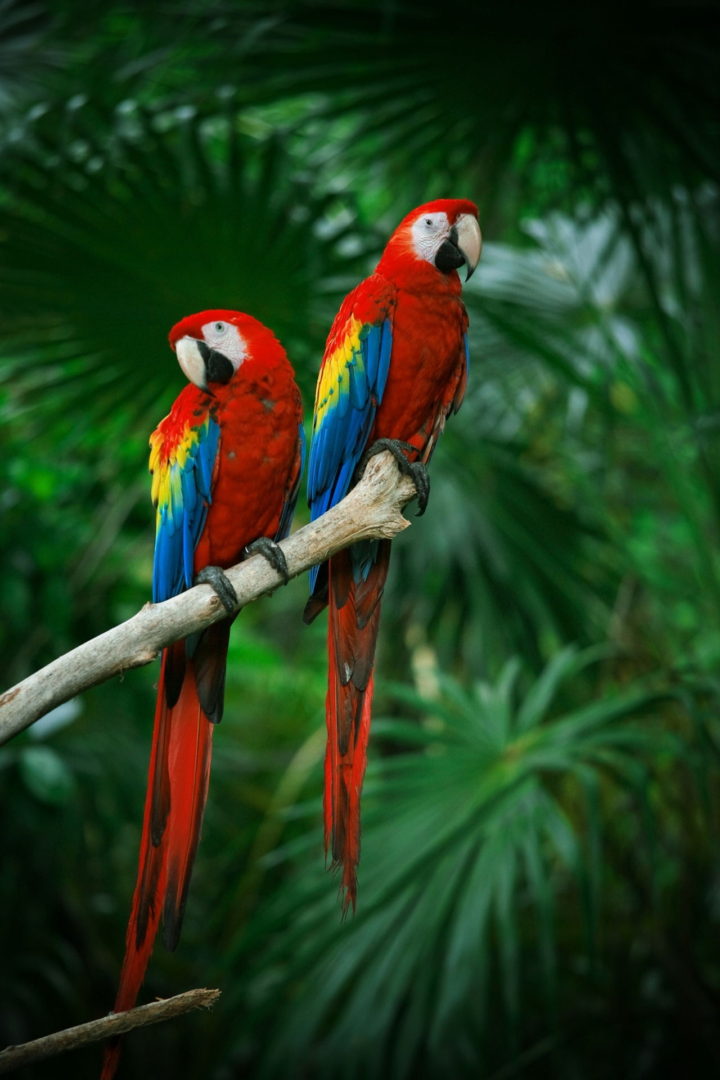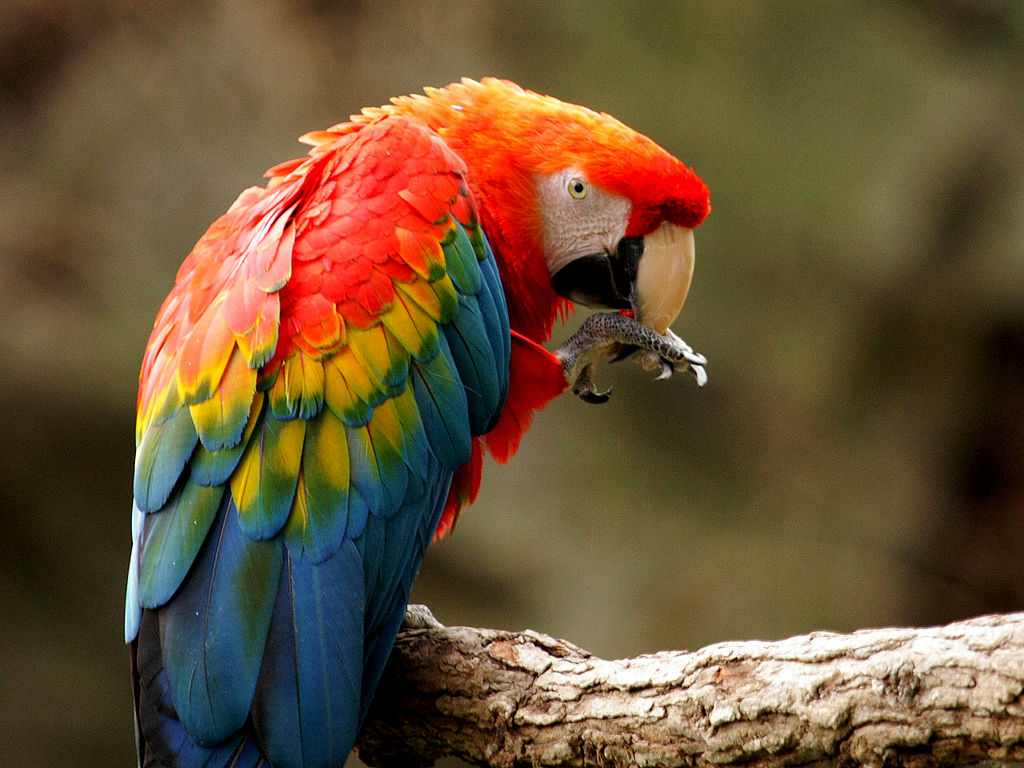The Scarlet Macaw is one of 17 species of macaw. It is a “sassy” bird, filled with energy and personality. It is highly intelligent, as well as a capable escape artist. The scarlet macaw is regarded by many as one of the most beautiful members of the parrot family and one of the largest Neotropical parrots. It sheer flashiness and dominant personality make it among the most popular of large parrot species as a pet. Confident and friendly, scarlets are usually eager to take on tasks such as learning tricks, and some even develop vocabularies of 5 to 10 words.

Scarlet Macaw In Flight | https://www.thesprucepets.com/scarlet-macaws-390840
Features of the Scarlet Macaw
- It has a lifespan of approximately 50 years.
- Scarlet macaws, certainly the most colorful with its large solid swatches of red, blue, and yellow. This beautiful macaw has a creamy white, almost featherless face, with bright red plumage covering most of its body, wings and long tail. It has feathers ranging in color bands from scarlet on their head and shoulders; yellow on their back and mid wing feathers and blue on the wing tips and tail feathers. The lower wing is mostly brilliant blue and yellow feathers. The eyes of the scarlet macaw are light yellow. Adding to that, the long, thick beak is light on the top and dark black on the bottom. The legs and feet are also black.
- The body of the scarlet macaw from beak to tail can be as long as 33 inches.
- They typically weight between 2 and 3 pounds.
- With wide strong wings and hollow bones that aid flight, they can reach speeds of 56 kilometers (35 miles) per hour.
- The scarlet macaw has a strong, curved beak to crack hard nuts and seeds, and a tongue that can hold onto the kernel to pull it from the shell. They eat clay from riverbanks, though no one is sure why.
- Males and females both look the same.
- While some learn to speak, most macaws have limited ability to mimic.
- Scarlet macaws have excellent vision and hearing.
Scientific Classification of the Scarlet Macaw
The scientific name for the scarlet macaw can be identified as “Ara Macao”.
Diet of the Scarlet Macaw
Scarlet macaw can be considered as an omnivore and so its diet includes fruits especially berries;, leaves, seeds, and nuts; insects and larvae during the breeding season. The Scarlet Macaw is known to consume fruits before they are ripe.
Adding to that, they also eat clay. High calcium greens such as kale and spinach are especially important. An all-seed diet is extremely unhealthy for these birds. As with all parrots, avoid chocolate and avocado, which are toxic. The diet of this macaw consists of fruit, seeds, pods, leaf shoots, flowers and occasionally insects.

Scarlet Macaw | © Dorian AndersonMacaulay Library ML80976381
Did you know the scarlet macaw can survive on what other animals can’t?
- Interestingly, the scarlet macaw can eat fruits toxic enough to kill other animals.
- Scarlet macaws occasionally consume clay which is thought to neutralize plant poisons found on the banks of rivers. This aids in digestion of the harsh chemicals such as tannins that are ingested when eating premature fruit.
Habitat of the Scarlet Macaw
The Scarlet macaw (Ara macao) has an enormous natural range in Central and South America and is found in two subspecies: Ara macao cyanoptera, which hails from Central America e.g Belize; and Ara macao macao, found in South America, e.g Guyana. The Central American scarlet is said to be larger and have more blue than green on its wings than the South American, if it has any green at all.
They prefer to spend their time in tall, deciduous trees in humid evergreen forests at elevations from about 1,000 to 3,000 feet.
That is, the canopy of humid, lowland rainforests and near rivers, usually in large, noisy groups. Mated adults preen each other and their offspring for hours, cleaning bugs from their feathers.
Reproduction of the Scarlet Macaw

A Pair of Scarlet Macaw | https://birdeden.com/scarlet-macaw-facts
Breeding in Ara macao occurs about every one to two years. As such, its reproduction is slow, and the breeding season varies with the latitude, rainy seasons, and fruit availability in each region of the American continent. In average the species lays one or two eggs, inside natural cavities that are either natural holes (i.e., broken tree limb) or made by another bird such as large woodpeckers (i.e., primary excavator) and some times they even excavated their own cavities in soft snags. They can use as a nesting site both live trees or snags. The chicks hatch on average after 28 days of incubation period of 24 to 25 days in which females mainly incubate the eggs. It remain in the nest until the age of 120 to 137 days, thus they spend between three and four months in the nest. The parents feed them four to 15 times a day. The young birds fly out of the nest together with the parents at between 97 and 140 days of age. They remain with the parents for up to almost one year, until the pair begins to nest again, although it has been recorded that on some occasions the pair will not nest again until the second year or when the previous young one have become independent. It is estimated that the young birds do not reach sexual maturity until almost three or four years of age.
Interesting facts about the Scarlet Macaw
There is no shortage of interesting facts about intelligent animals, especially when it comes to the Scarlet Macaw. These birds, are known for their beautiful bright plumage, curiosity, strong willed and highly trainable in captivity. What distinguishes the Scarlet Macaw from other Macaws is its white face and yellow feathers on its wings. Their natural habitat is in the South American rain forests where it is moist and humid. Their intelligence and beauty are two reasons why people keep them as pets, but because of their ability to become aggressive they do not make good pets for kids.
- Studies have concluded that Scarlet Macaws have the intelligence to distinguish colors and shapes. with the right trainer, some of these birds can even perform simple math problems.
- Scarlet Macaws are said to have the intelligence of a 4-8 year old child with the emotional intelligence of a 2 year old. This means that they can be demanding and cranky and even throw temper tantrums if not given proper attention.
- During breeding season, which is between October and April, the birds can become very territorial and even aggressive
Watch: Xcaret saving scarlet macaw (Mexico)
The scarlet macaw reproduction program contributes to the dream of preserving this endangered species. Xcaret will continue working through the next years, so that the scarlet macaws keep coloring the skies of Mexico and Central America.
Article References
- https://neotropical.birds.cornell.edu/Species-Account/nb/species/scamac1/breeding
- https://lafeber.com/pet-birds/species/scarlet-macaw/
- https://www.rainforest-alliance.org/species/macaw
- https://animaldiversity.org/accounts/Ara_macao/
- https://www.aviary.org/animals/scarlet-macaw
- https://ebird.org/species/scamac1
- https://animalcorner.co.uk/animals/scarlet-macaw/
- https://animals.mom.me/eating-habits-scarlet-macaw-parrots-4448.html
- https://switchzoo.com/profiles/scarletmacaw.htm
- https://www.thesprucepets.com/scarlet-macaws-390840
- http://www.torontozoo.com/ExploreTheZoo/AnimalDetails.asp?pg=544
- http://www.hhpz.org/files/hhpz/documents/AnimalFactSheets/Scarlet%20Macaw.pdf
- http://www.animalspot.net/scarlet-macaw.html
- https://interesting-animal-facts.com/Intelligent-Animals-Facts/Scarlet-Macaw-Facts.shtml
- Main Image: Travis Isaacs from Grapevine, TX, USA [CC BY 2.0 (https://creativecommons.org/licenses/by/2.0)]







